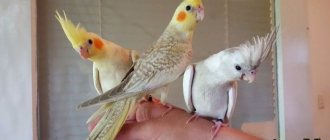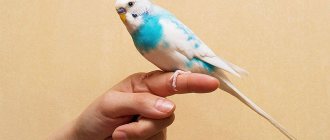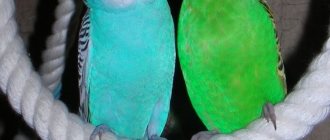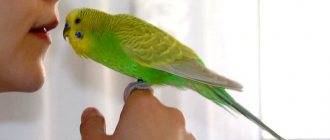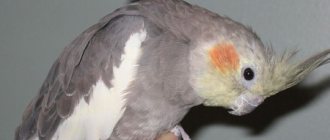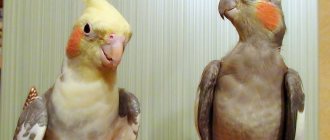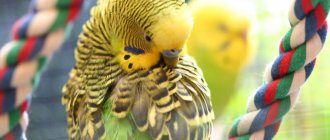When purchasing parrots, an important factor is their ability to learn. Fortunately, owners of wavy birds can rest easy, because these birds are the most susceptible to training. They are like sponges, instantly absorbing what is happening around them. Plus, they adapt quite quickly to the new environment.
It may take several days for them to completely get used to it. It has been proven that the imitation of human speech and movement is inherent in them at the genetic level. Therefore, with the right motivation and approach, devoting just 15 minutes a day, your pet will very soon begin to amaze others with its skills.
Natural abilities of a budgie
The small green, yellow and blue birds have long been one of the most popular pets. Budgerigars delight their owners not only with their bright colors, but also with the unusual abilities given to them by nature.
The most famous talent of budgerigars is sound imitation. Parrots perfectly remember and clearly reproduce not only mechanical sounds (whistles, clicking, etc.), but also human speech. However, it is worth noting that wavy animals unconsciously repeat certain words after a person.
Budgerigars can also copy human movements and follow simple commands.
Parrots have the ability to learn quickly, so to achieve great results with your feathered pet should be exercised daily.
About the intelligence of birds
Parrots can really speak: not just repeat individual words after you, but pronounce them consciously. This opinion is shared by ethologists who study animal behavior. The resourcefulness of these birds is also sometimes amazing. A living example is a cockatoo parrot named Figaro.
Did you know? Alex, a representative of the Gray parrot species, is considered the most talking parrot, which is recognized by the Guinness Book of Records. He knew 400 words and could say a whole coherent sentence.
He was able to figure out how to get the nut from outside his enclosure using a stick, which he also tore off from the board himself, selecting the desired length. So these birds are not stupid and are very amenable to education and training. But it takes a lot of effort to get your bird to talk.
Where to start training a wavy
Training must begin when the parrot has become completely accustomed to its new environment and has become accustomed to new people. A newly acquired budgie needs time to adapt: it must explore its new home so that nothing frightens it in the future.
After the parrot gets used to it, you should begin to tame it to yourself. It is recommended to train a budgie when it is not afraid to eat from your hand.
In order to achieve trusting contact with your feathered pet, you need to constantly be in its field of vision. The parrot must get used to the fact that you are always nearby. Then, over time, try holding out your hand to him with grain or other treats sprinkled on it. If the wavy fish starts eating from your hand, then you can safely begin training.
Classes should always be held in the same room. You need to choose a place where the parrot cannot be distracted by any extraneous sound or moving objects.
Before you start training, it is worth considering a reward system. Traditionally, your feathered pet's favorite treat is used as praise. Observe the wavy while feeding to determine its preferences for a particular food.
Words of praise are no less important. But for each achievement the parrot must be praised with the same word, while always maintaining the same intonation. This way the budgie will always understand that you are happy with it.
You should start training with simple commands or short words if you are teaching your wavy to talk.
Methods
Before you start taming a parrot, be prepared for the fact that for a successful result you will have to spend a lot of personal time. No haste or pressure on the bird is acceptable; any actions should strengthen trust and not destroy it. For the first 2-3 days after the purchase, the parrot is confused and scared, sits silently, is ruffled and quietly sad. This is fine. Leave the bird alone these days.
By nature, parrots are very sociable, so even the most stubborn of them will not sit in the corner of the cage alone for a long time. After a couple of days, the pet will recover a little from stress, will stop rushing to the far corner of the cage when you appear, and will begin to peck food from the feeder when you are in the room. Now you can begin to accustom him to your hands.
Ornithologists suggest following gradual steps in taming.
- First, try to interest your pet in communication. At first, do not come close to the cage and talk to the bird from a distance in an even, soft voice, calling the pet’s name. Then begin to slowly approach the cage so that the bird understands that you are addressing it. Observe your parrot's gestures to see if he is listening to the sounds of your voice. Be prepared to perform this initial stage especially carefully, show maximum patience and do not rush to move on to more active actions.
- Through observation, determine what your parrot likes to eat most. See what he chooses from the feeder first (grain, fruit, nuts, something else). During taming, do not put this food in the feeder, but use it as a treat to encourage the parrot during training.
- For the first time, try to grab just a little bit of your favorite food with your fingers in a pinch and offer it through the bars of the cage. There is no point in opening the cage door and rushing to put your hand inside - the parrot is not yet ready for this. Most likely, he will not take food the first time even through the bars. Don't insist, wait a few minutes and move away from the cage. Offer the treat a second time before feeding again. Perhaps a hungry bird will take a treat. As soon as this happens, praise him in a kind voice and additionally reward him with a treat. Do this step several times.
- After about a week, you can offer treats by hand through the door. Place the treat in your open palm and wait. Calmly continue talking to the bird, don’t rush it, don’t try to convince it to eat the “yummy” food. Wait until the pet decides to approach the hand. This should be done in the morning, when the parrot is alert and hungry. There is no need to extend your hands far into the cage, since at first all parrots are afraid of hands, but this will pass. Do this patiently every day.
- The moment will come when the bird itself will take food from the palm. First, he will grab a grain or nut, bounce from the hand to the far corner of the cage and enjoy the treat in a safe area. Remain calm, do not be nervous, once again be patient and do not scold the bird under any circumstances. The parrot will soon understand that there is no danger, you are not trying to take away the food or grab it. After some time, he will boldly sit in your arms and enjoy the treat without moving deeper into the cage.
- Now you can train your bird to sit on your finger. Place your outstretched finger on the perch where your pet likes to sit. Usually this is enough - the parrot itself jumps onto the finger. But sometimes he simply does not understand what is needed from him. Touch the feathers on the belly in front between the legs, and the parrot will quickly sit on your finger.
We invite you to familiarize yourself with the Budgerigar - a talkative tenor. Description and photo of budgerigars During the training process, it sometimes happens that some parrots cannot be tamed. Don’t deviate from your plan, find another way to interest the bird. You can try to accustom your pet to your hand using a small mirror. Quietly move the mirror in front of the bird, bringing it closer to your open palm and moving it away from the bird.
Special care is required on your part. No sudden movements or hasty gestures, do not risk losing trust. Instead of a mirror, there may be another object - a pen cap, a bottle cap, a new toy - parrots love to tinker with such things. If you manage to find an object that interests the bird, the rest will depend on your desire for success, the sequence of your actions, and everything will certainly work out.
Teaching your parrot commands
A budgie can be trained at home to follow certain commands. The main thing is to build classes on the principle of alternation: learning new things and consolidating old ones. The daily lesson should last at least 10 minutes (over time, the duration can be increased depending on the condition of the parrot). It is important to teach in a calm but loud voice. You cannot scream or make sudden movements - this will scare the wavy.
For the first lessons, you can take a team that will call the parrot to you. The command word can be the name of the parrot or any other word or phrase (for example, “to me”). Thus, call the parrot by placing your hand or patting the place where he should sit. The main thing is to put a treat in that place.
The commands can be very different: “eat”, “swim”, “bring”, “throw”, etc. The main thing when learning is to observe intonation when pronouncing a command and accompany it with specific gestures. So, for example, when giving the command “bathe”, you should show the spray bottle (if you are using it to wash a parrot) or point to the bathtub in the cage. When using the command “up” (“jump”), you need to place your hand or perch towards the parrot. Also, every time the wavy jumps onto the perch, it is worth repeating the desired command loudly. With constant repetition, your budgie will begin to listen to you.
If you decide to start a lesson, but the parrot does not pay attention to you: it sits with its back or side to you, does not want to look in your direction, then it is better to cancel the lesson this time. You should not force your parrot - this will only worsen your relationship (he may be offended and not allow you to come near him anymore).
It is important to reward the parrot with a treat for each command performed.
Hand Taming
Taming by hand is the final moment in the process of training a bird.
Before you begin taming, it is important to make sure that your pet is ready for training:
- Not afraid of a person approaching his home;
- Calmly sit on your hands within the cage;
- When flying out of the home, it calmly returns back after some time;
- While flying out of the house, it tries to sit on the head of the owner and other family members.
The main condition for training is friendliness and readiness for contact; it is forbidden to start training by forcing the bird to interact.
It is important to start the training process in the morning, before the bird has breakfast. The next stage must take place outside the cage
Before the pet begins to freely contact a person, it is necessary to teach the budgerigar to sit on a finger without fear, like on a perch in a cage. To do this, just extend your finger towards the parrot, it will quickly find its bearings and sit on it.
Important Tips
When choosing where to purchase your pet, it is important to remember that birds from pet stores will be more difficult to train. This is due to the fact that budgerigars, from birth, living in a cramped cage in a store, regularly experience stress
Knowledge of how to tame a budgie is not always enough for quick and effective training. It is important to follow all the recommendations and subtleties in training this bird. Recommendations for taming a bird:
- Training should take place in the morning, when the pet is in a good mood;
- It is recommended to remove the feeder from the home at night, so the bird will be more willing to take food offered from your hands;
- Before training, it is prohibited to wash your hands using scented products or smear them with cream;
- The owner's hands should not have a strong tobacco smell.
Difficulties that may arise
The main difficulty that may arise during training is refusal to contact a person. But without communication, even the most fearful and cautious parrot cannot exist for long. The main thing in this case is to be patient, tune in to a longer period of taming and not make mistakes in training, after which the pet may become very frightened.
There are several training techniques when a pet categorically refuses to make contact:
- Offer him a toy, an imaginary friend that he can happily feed and care for;
- Place a mirror in the cage; parrots love to look at their reflection;
- Pull the toy out of the lid or ballpoint pen.
When training and feeding an individual from the palm of your hand, the parrot may fly out of its home. Another difficulty may be the pet’s reluctance to return to its cage. We need an effective and safe way to bring it back. The method is used after dark. It is necessary to remember the location of the individual and, with the light source turned off, in complete darkness, carefully pick it up and put it in the house
It is important to turn on the light only after the parrot is inside. After this, the bird will not be afraid of humans, this is due to the inability to see the parrot in the dark
Teaching your parrot tricks
Training a budgie should be done by one person. If all family members try to train the parrot, there will be no success. But the only one who will train the bird needs to gain trust.
Training should take place at a time when the budgie is hungry. If the wavy is already full, then it is unlikely that he will want to exercise. After all, the parrot has already eaten enough food, so there is no longer a need to exercise for the sake of encouragement - a favorite delicacy.
You should not approach parrots in an upset, angry or other bad mood. Budgerigars perfectly sense the emotional state of people. A person who is out of sorts will simply scare away the bird.
It is also important when training not to make sudden movements and not to force this or that action on the parrot. You will get more positive results if you show calm and patience until the parrot pays attention to you.
Classes should always be held at the same time. This way, the budgie will get used to the lessons faster and will then remind you of the lessons (for example, by flying to you and placing a training ball on your hand).
It is recommended to train budgies in the format of a game or conversation. For example, a parrot can be taught to dance. To do this, you need to put him on your hand and turn on the music. Shake your palm to the beat, rotate your head - create an imitation of dance. If the budgie likes your actions, he will begin to repeat after you. But don't be upset if the wavy won't do anything. Try changing the music and repeating again.
In addition to dancing, a parrot can be trained to play with a ball. To do this, buy the wavy a ball with a bell inside and a basketball hoop in accordance with the size of the bird. Show your parrot how you throw a ball into a hoop; if the parrot is interested in this, he will begin to try to play.
Conditions for classes
For successful training, you must adhere to the basic rules:
- Reward your pet with a treat after performing a trick. There should be no strangers or noise in the room.
- When learning any trick, you should not overload the task with unnecessary movements. Improvisation by the owner and leapfrog commands will confuse the pet; demands must be made sequentially. Only after learning one trick and consolidating the lesson do they begin the next one.
- To make the lessons easier for your pet to learn, you need to clearly demonstrate movements and objects. The intonation of spoken commands should be emotionally charged.
- Signal words are pronounced clearly in a loud voice. At the same time, if you fail, you should not cry out. Angry, harsh words offend the pet, and he stops making contact.
- In a restless or nervous mood, training is not carried out. The owner's inner mood is easily transmitted to the parrot.
Classes are carried out by only one person. The bird recognizes the authority of the owner if he feeds, cares for and studies without changing the teacher.
Learning ability
For many of us, there is no more symbolic image of the diversity of animal life on the planet than Noah's Ark. The extent to which animal species differ from each other is truly amazing. And most of all, this diversity is embodied and confirmed by the order of Parrots. After all, it includes more than 300 species of parrots. Parrots are so amazing both in color and in their behavior that they deserve their own separate ark.
The animal kingdom is also notable for one more feature, perhaps not so obvious, but no less surprising. Despite all its enormous diversity, there is something in common that unites it with us. So what do whales, elephants and songbirds have in common with parrots and us humans? Of course, this is something we can all learn from, i.e. change your behavior as a result of your experience.
Learning is a mechanism completely different from inherited behavior. Learning ability does not imbue someone with a pattern to behave one way or another in any particular situation. On the contrary, it serves to enable the individual to change his behavior in order to suit any situation. This is a more advanced form of modifiability. Only learning ability allows an individual to quickly adapt to changes in the environment.
